I Chose DO, PM&R Chose Me
Published January 15, 2023
By AACOM
Choose DO
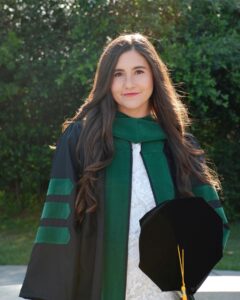 Dr.
Finger's graduation from the Texas College of Osteopathic Medicine, UNT Health Science Center, Class of 2020.
Dr.
Finger's graduation from the Texas College of Osteopathic Medicine, UNT Health Science Center, Class of 2020.
To this day, when Dr. Finger looks down at her white coat, embroidered with the letters DO, she finds herself thinking "how cool is this?"
Dr. Finger describes herself as an adventure chaser, health nut, and PGY-1 Resident Physician, Physical Medicine and Rehabilitation (PM&R), at UT Health San Antonio. Before medical school, she received her B.S. in Nutritional Science from The University of Texas at Austin, conducted nutritional birth-defect research at the Dell Pediatric Research Institute, led body acceptance workshops for The National Institutes of Health, and developed several public health initiatives for University Health Services at The University of Texas. Dr. Finger believes in the importance of nutrition and physical activity as part of a healthy lifestyle. When Dr. Finger first decided to become a physician, she didn’t know what osteopathic medicine was. It wasn't until she began the process of applying to medical school, that she discovered the DO pathway. Like many pre-medical students, she described herself as being confused and even apprehensive when she first learned that there are two types of fully-licensed physicians. We recently spoke with Dr. Finger about her journey to medicine, why she chose osteopathic medicine specifically, and what advice she hopes pre-med students today will take to heart.
How did you your journey to medicine begin, and more specifically, why did you choose DO?
Pretty early in life, I "decided" to become a physician. I put "decided" in quotes because at that time I had no idea what being a doctor entails, nor did I have what one might consider a good reason as to why I wanted to be one. It just sounded pretty cool to teenager Nicolet. With this is mind, I joined a program in high school called Health Occupations Students of America (HOSA), which allowed me to spend part of my junior and senior years shadowing physicians in various specialties. This gave me more insight into the world of medicine, and I decided to continue on this path as I transitioned to college.
At the University of Texas at Austin, I chose to major in Nutritional Science because it's an important aspect to medicine that most medical students
don't learn much about. I was still able to get the majority of my medical school pre-requisites within my degree. During undergrad, I kept very busy with extracurriculars. I held a couple part-time jobs in public health, -- one working for my university
to promote safe-sex and healthy habits in college, and the other working for the National Institutes of Health (NIH) to prevent eating 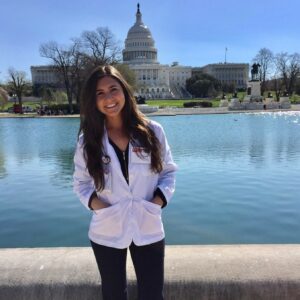 disorders.
Additionally, I became interested in research after being accepted to my university's Freshman Research Initiative (FRI), where I researched new drugs to treat infectious diseases. This then led me to conducting research at the Dell Pediatric Research
Institute (DPRI) where I studied how nutrition plays a role in birth defects. I fell in love with the fact that public health and scientific advancements could improve the lives of many.
disorders.
Additionally, I became interested in research after being accepted to my university's Freshman Research Initiative (FRI), where I researched new drugs to treat infectious diseases. This then led me to conducting research at the Dell Pediatric Research
Institute (DPRI) where I studied how nutrition plays a role in birth defects. I fell in love with the fact that public health and scientific advancements could improve the lives of many.
So how did I ultimately decide to become a physician? I knew that I wanted to develop relationships with my patients, working one-on-one with them and creating a holistic plan to improve their health and function. Now, maybe it’s my rose-colored glasses that I use to look at the world, but as a pre-med student I thought that all doctors were trained to listen; to pay more attention to their patients than their patients’ charts.
I thought the principal to promote the body’s natural tendency toward health and self-healing was taught in every medical school. But in my experience, I found this focus to be unique to osteopathic medicine. Identifying strongly with these principles, the core of the osteopathic philosophy, I found myself running full speed towards the DO degree. I have always believed in a holistic approach to health.
I wanted to be a well-rounded physician with as many tools in my patient-care toolbox as I could carry. So, when it came time to apply for medical school, I decided that the best route for me would be osteopathic medicine. I heard about the holistic principles
built into the foundation of osteopathic medicine and I wanted to learn osteopathic manipulative medicine (OMM). OMM principles and techniques can be used in every specialty!
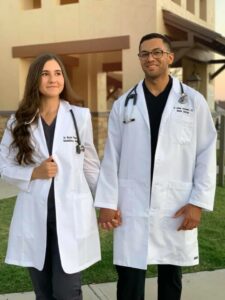 Dr.
Finger & her fiancé, Dr. Joshua Hernandez.
Dr.
Finger & her fiancé, Dr. Joshua Hernandez.
When did you know PM&R was the right specialty for you?
I actually went into medical school thinking I would become an OBGYN! Though a great specialty, I didn't find what I was looking for in that specialty. I didn't come home excited, and this scared me. I want to be excited about what I do every day! So I decided to explore other specialties. Luckily, a friend of mine who was going into PM&R gave me the email of his mentor, Dr. Omar Selod, DO.
I reached out to Dr. Selod and went for a meeting with him to pick his brain about the specialty. During that meeting, I decided I would like to do an elective rotation with him, but all of his rotation spots for the year were full! And then the moment we still laugh about today happened -- his scheduler walked in the room and said that someone had just cancelled their elective. We like to say that was my life-changing moment, because I took that elective spot and within the first week of my rotation with him I knew PM&R was for me. I fell in love with giving people hope, optimizing their function, and in turn improving their quality of life.
What does a day in the life of a PM&R Resident look like for you?
PM&R residency consists of one intern year and three advanced training years. Some people match into separate intern and advanced programs, but my program is a combined program (referred to as categorical) with all four years in the same program with
the same program director. During int
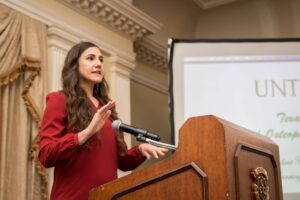 ern
year, we rotate through a variety of specialties that allow us to set a strong foundation for which we can then build our physiatry knowledge on. This year I am rotating through internal medicine, intensive care (ICU), orthopedic surgery, neurology,
rheumatology, and geriatrics in addition to a month of PM&R consults. Then next year, starting as a PGY-2 resident, my schedule will be packed with all sorts of PM&R rotations such as spinal cord injury, traumatic brain injury, inpatient rehabilitation,
sports medicine, pain management, electrodiagnostics, and so much more!
ern
year, we rotate through a variety of specialties that allow us to set a strong foundation for which we can then build our physiatry knowledge on. This year I am rotating through internal medicine, intensive care (ICU), orthopedic surgery, neurology,
rheumatology, and geriatrics in addition to a month of PM&R consults. Then next year, starting as a PGY-2 resident, my schedule will be packed with all sorts of PM&R rotations such as spinal cord injury, traumatic brain injury, inpatient rehabilitation,
sports medicine, pain management, electrodiagnostics, and so much more!
As you can see, it’s difficult to describe what one single day looks like in residency, but I try to share as much as I can day-to-day on my Instagram @nicolet.life!
Any open-ended advice for pre-medical students?
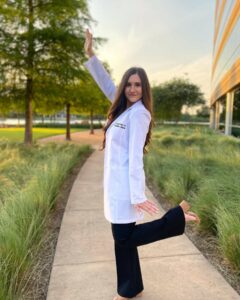
Learn how to study actively! For example, passive learning includes things like reading, listening to lectures, or flipping through PowerPoint slides. While this is a necessary part of learning, it should be the minority of where you spend your time.
Active learning includes things like practice questions, flash cards, and drawing out figures/diagrams. This is where you should spend the majority of your study time! And lastly, don't compare your journey to any one else's! You are unique, and what YOU bring to medicine is what we need.
Dr. Nicolet Finger is a graduate of Texas College of Osteopathic Medicine, UNT Health Science Center. Connect with Dr. Finger: Blog: www.nicolet.life Instagram: @nicolet.life Facebook: nicolet.life TikTok: @nicolet.life Twitter: @DrNicoletFinger
